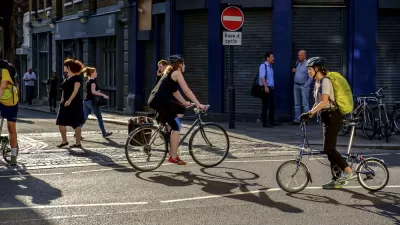According to Chris Peck, “Better cycling infrastructure, an enforced road traffic law and a reduction in the space available to motor traffic are all required to get cycling growing again in London.”
"The mayor of London's 'cycling Revolution', launched in 2010, was revolutionary in name only,” writes Chris Peck, policy coordinator of the UK's national cyclists' organization, the Cyclists' Touring Club (CTC). A bit of a mixed bag, London's citywide cycling campaign has seen its share of successes and failures. Accomplishments include the implementation of a bicycle borrowing system, the creation of cycling superhighways, and ushering in a 10-15% increase in cycling levels. But, all this development has been costly for London at about £10 per head, and several high-profile deaths and what many feel is poorly design cycling infrastructure and regulation have been accompanied by a recent decline in cycling levels.
Since 2007, “both nationally and in London, cycle casualties have been increasing faster than the rate of cycling, undermining the idea that if you get more people cycling, it will inevitably become safer,” writes Peck. In fact, he asserts that in London, unlike in cities such as Copenhagen and Amsterdam, the “safety in numbers” idea has failed to materialize. This is due to a variety of factors related to both infrastructure and policing, as well as road user behavior. "The problem with so much existing cycle infrastructure is that it does little to improve safety, but also undermines the status of cycling, relegating them to a narrow, unhelpful cycle lane the users of which must give way to all other road users," writes Peck.
FULL STORY: Why is there no safety in numbers for London's cyclists?

Alabama: Trump Terminates Settlements for Black Communities Harmed By Raw Sewage
Trump deemed the landmark civil rights agreement “illegal DEI and environmental justice policy.”

Study: Maui’s Plan to Convert Vacation Rentals to Long-Term Housing Could Cause Nearly $1 Billion Economic Loss
The plan would reduce visitor accommodation by 25% resulting in 1,900 jobs lost.

Planetizen Federal Action Tracker
A weekly monitor of how Trump’s orders and actions are impacting planners and planning in America.

Waymo Gets Permission to Map SF’s Market Street
If allowed to operate on the traffic-restricted street, Waymo’s autonomous taxis would have a leg up over ride-hailing competitors — and counter the city’s efforts to grow bike and pedestrian on the thoroughfare.

Parklet Symposium Highlights the Success of Shared Spaces
Parklets got a boost during the Covid-19 pandemic, when the concept was translated to outdoor dining programs that offered restaurants a lifeline during the shutdown.

Federal Homelessness Agency Places Entire Staff on Leave
The U.S. Interagency Council on Homelessness is the only federal agency dedicated to preventing and ending homelessness.
Urban Design for Planners 1: Software Tools
This six-course series explores essential urban design concepts using open source software and equips planners with the tools they need to participate fully in the urban design process.
Planning for Universal Design
Learn the tools for implementing Universal Design in planning regulations.
Caltrans
Smith Gee Studio
Institute for Housing and Urban Development Studies (IHS)
City of Grandview
Harvard GSD Executive Education
Toledo-Lucas County Plan Commissions
Salt Lake City
NYU Wagner Graduate School of Public Service





























